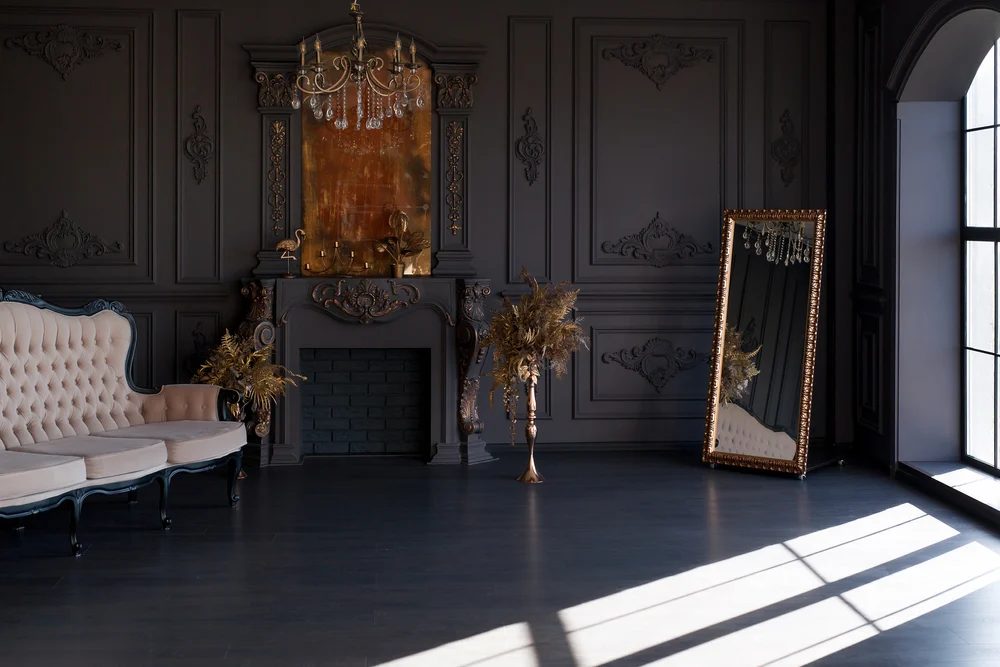Gothic decor has transcended its medieval origins to become a timeless aesthetic that balances darkness and beauty in perfect harmony. This distinctive style marries the macabre with the elegant, creating spaces that feel both mysterious and welcoming.
The allure of gothic decor lies in its ability to transform ordinary rooms into extraordinary sanctuaries of dramatic expression.
Whether you’re drawn to the rich historical elements of traditional gothic design or prefer a more contemporary interpretation, gothic decor offers versatile possibilities for personalization.
The style’s characteristic features—ornate detailing, dramatic contrasts, and a celebration of the unconventional—provide a foundation for creating spaces that are uniquely captivating.
Gothic Home Decor Ideas
From subtle gothic accents to full room transformations, the following ideas will guide you through incorporating this enchanting aesthetic into your home, allowing you to create an atmosphere that’s both hauntingly beautiful and genuinely livable.
1. Dramatic Wall Colors
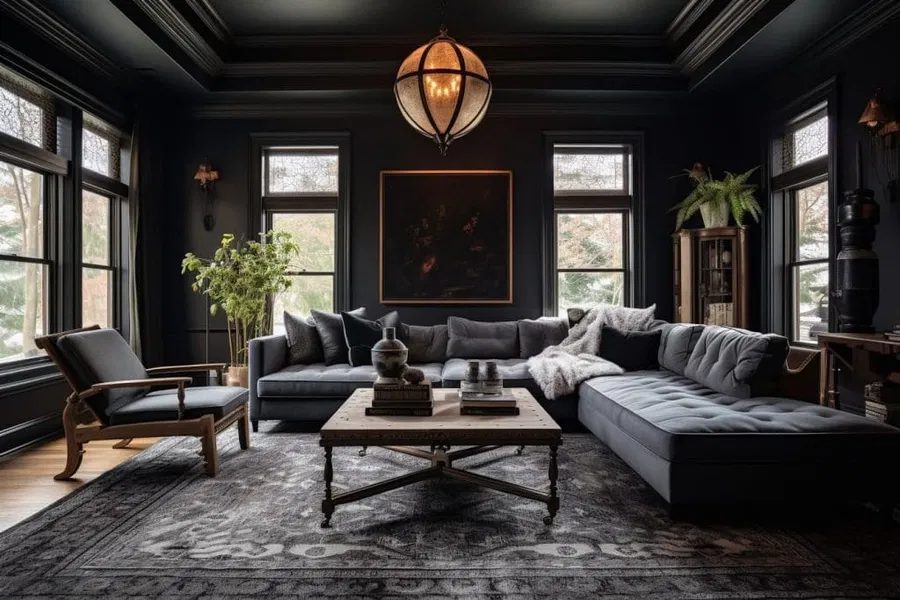
The foundation of gothic decor begins with the right wall color. Deep, rich hues create the perfect backdrop for this dramatic style. Consider painting your walls in shades of burgundy, purple, midnight blue, or the classic gothic black for an instantly transformative effect.
For those hesitant to commit to completely dark walls, consider an accent wall or wainscoting painted in a deep shade. This approach maintains the gothic aesthetic while keeping the space from feeling overwhelmingly dark. Alternatively, textured wallpaper featuring damask or floral patterns in dark colorways offers another way to incorporate gothic elements while adding visual interest and dimension to your walls.
2. Victorian-Inspired Furniture
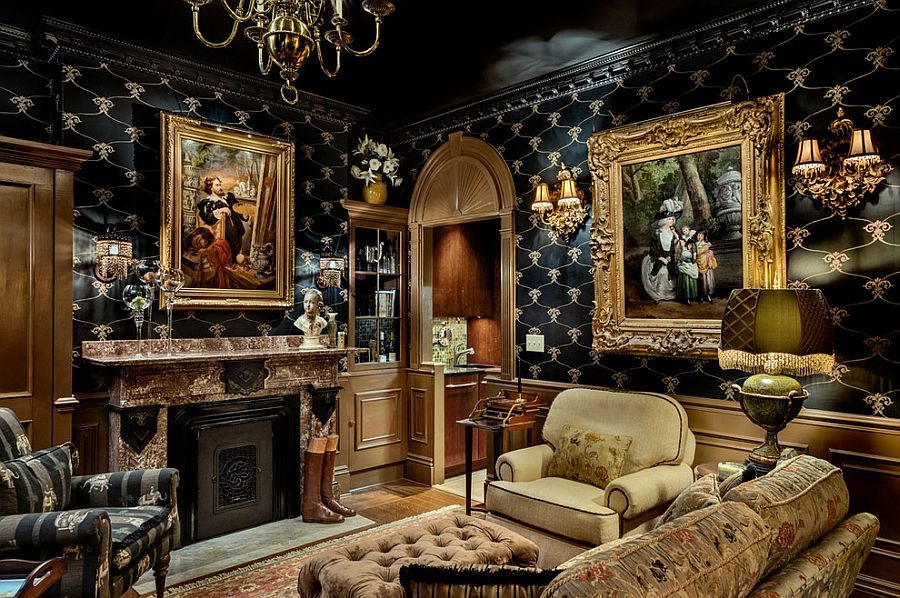
Ornate Victorian-style furniture pieces are essential elements in gothic home decor. Look for chairs, sofas, and tables with carved details, button tufting, and curved silhouettes. Materials like dark wood, velvet upholstery, and brass accents enhance the gothic atmosphere.
When selecting furniture, prioritize pieces with dramatic proportions—high-backed chairs, canopy beds, and substantial armoires make powerful statements. Don’t be afraid to mix genuine antiques with quality reproductions to achieve the look while staying within budget. Remember that patina and signs of age add authenticity to the gothic aesthetic, so embrace furniture that tells a story through its imperfections.
3. Ornate Mirrors
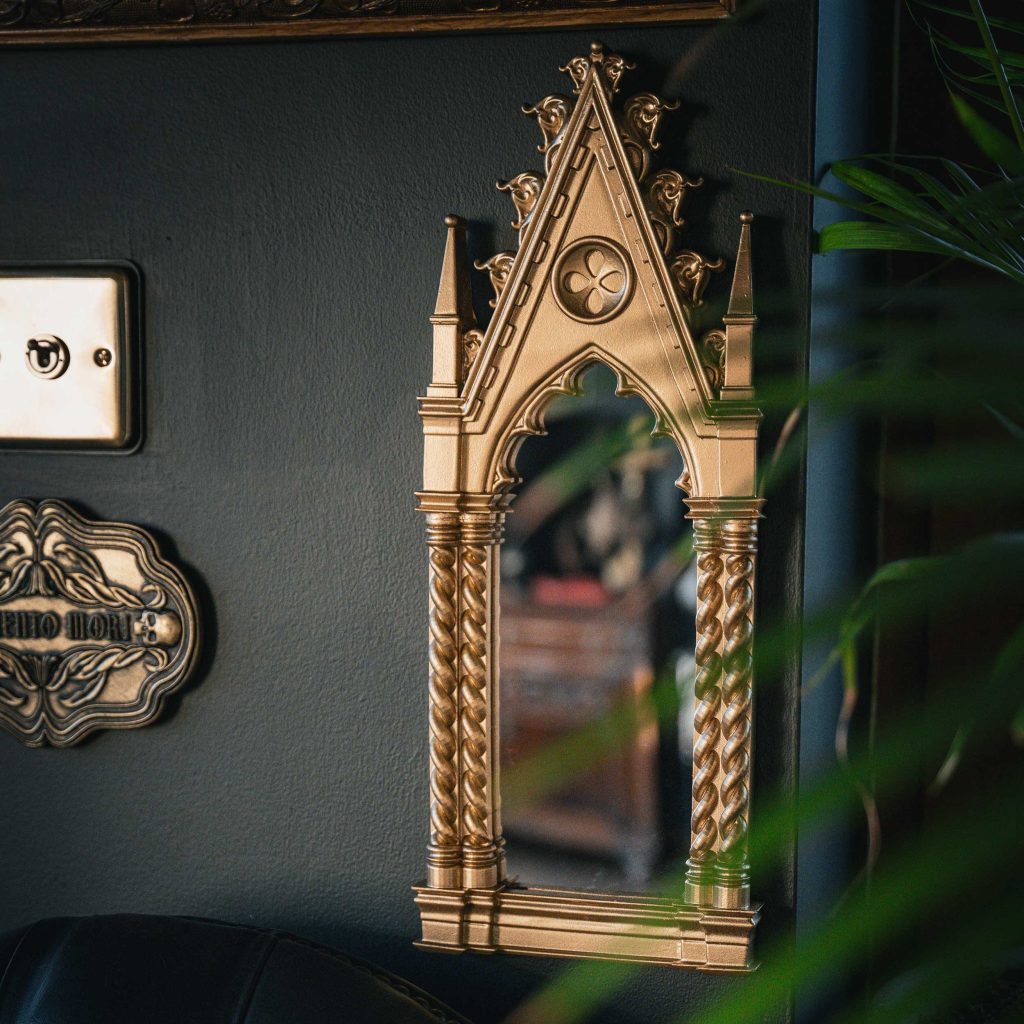
Mirrors are not merely functional in gothic decor—they’re statement pieces that expand space while adding mystery. Choose mirrors with elaborate frames featuring intricate carvings, scrollwork, or even gargoyle motifs. Antiqued or smoky glass enhances the ethereal quality that complements gothic design.
Position mirrors strategically to reflect candlelight or chandeliers, multiplying the ambient lighting effect. A large leaning mirror with an ornate frame can become a focal point in your bedroom or hallway. For a more subtle approach, cluster several smaller gothic-style mirrors on a wall to create an elegant gallery effect that maintains the dramatic aesthetic without overwhelming the space.
4. Candelabras and Candlesticks
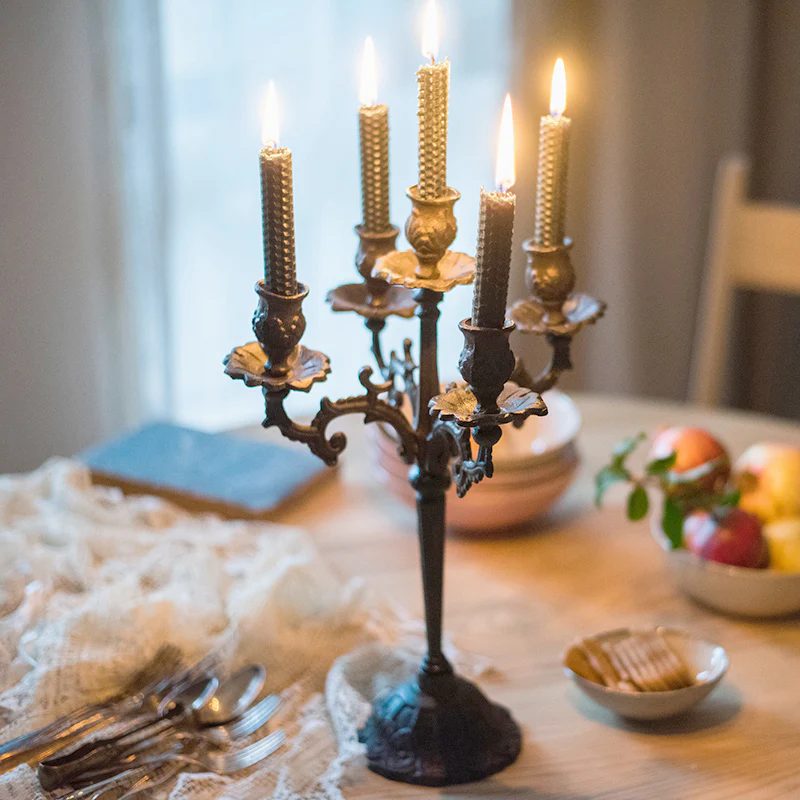
Nothing evokes gothic ambiance quite like the flickering glow of candles. Invest in statement candelabras for tables and sideboards, and tall candlesticks for mantels and shelves. Choose designs in wrought iron, brass, or silver with intricate detailing for authentic gothic character.
For modern convenience without sacrificing atmosphere, consider flameless LED candles that provide the same ambiance without fire hazards. Place candelabras at different heights throughout your space to create visual interest and dramatic shadows. For special occasions, enhance the effect with deep-colored candles in rich burgundies, purples, or blacks to complement your overall color scheme.
5. Stained Glass Accents
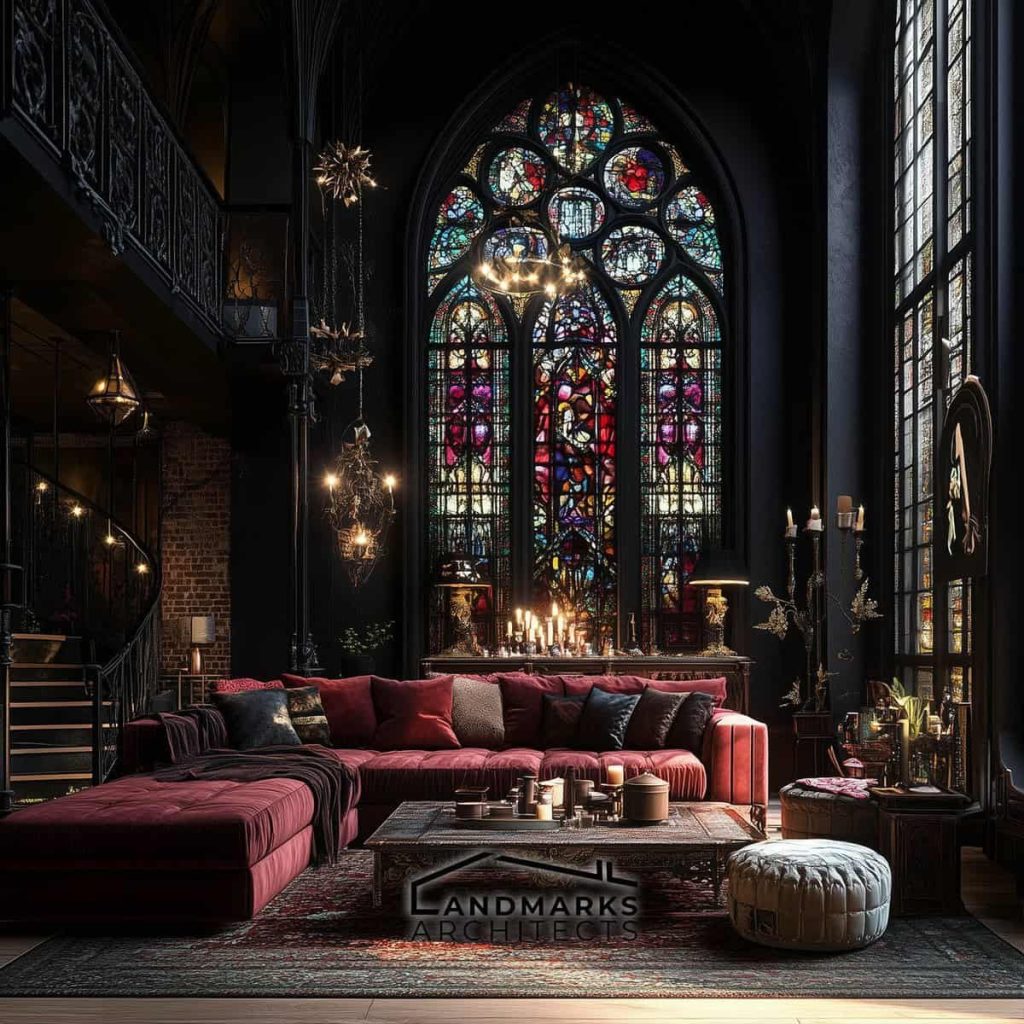
Incorporate the enchanting beauty of stained glass to infuse your space with colored light and gothic cathedral influences. Hanging stained glass panels in windows creates dramatic light effects throughout the day, transforming the atmosphere of your room with minimal effort.
If architectural installation isn’t possible, consider stained glass lamps, candle holders, or decorative panels that can be displayed on stands. Look for designs featuring gothic motifs like roses, quatrefoils, or medieval-inspired imagery. For a personalized touch, commission a custom piece that incorporates colors and symbols meaningful to you, creating a unique focal point that perfectly complements your gothic decor vision.
6. Luxurious Dark Textiles
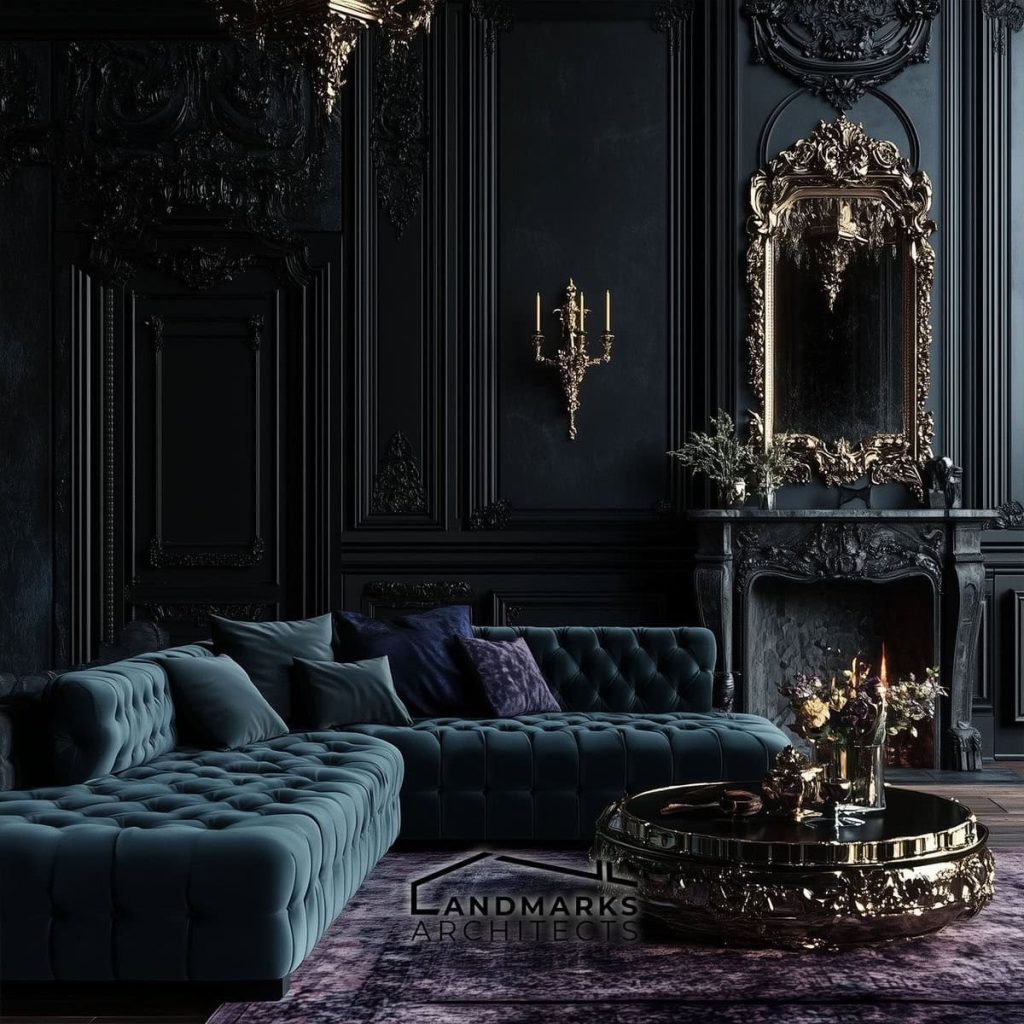
Sumptuous fabrics in deep, rich colors are fundamental to creating a gothic atmosphere. Incorporate velvet, brocade, damask, and silk in shades of burgundy, emerald, royal purple, or black throughout your space. These textiles add both visual and tactile luxury to your gothic interior.
Layer different textures for depth and interest—velvet curtains against silk wallpaper, or brocade pillows atop leather furniture. Don’t forget the floors; area rugs with ornate patterns in deep colors ground the space and add warmth. For bedding, choose high-quality linens in dark colors or with subtle gothic patterns, and consider a dramatic canopy or bed curtains for the ultimate gothic sleeping sanctuary.
Related Guide: 50 Halloween Ideas
7. Antique Books and Curiosities
Create intriguing vignettes with collections of antique books, vintage scientific instruments, or Victorian curiosities. These objects add authenticity and intellectual depth to your gothic decor while providing conversation pieces that reflect the style’s appreciation for knowledge and the unusual.
Visit antique shops, estate sales, and online marketplaces to source interesting specimens like vintage magnifying glasses, antique globes, or decorative hourglasses. Display your collections on bookshelves or under glass cloches for protection and added visual interest. Group items thematically—scientific instruments together, or books arranged by color—for a curated look that maintains order within the eclectic gothic aesthetic.
8. Gothic Architectural Elements
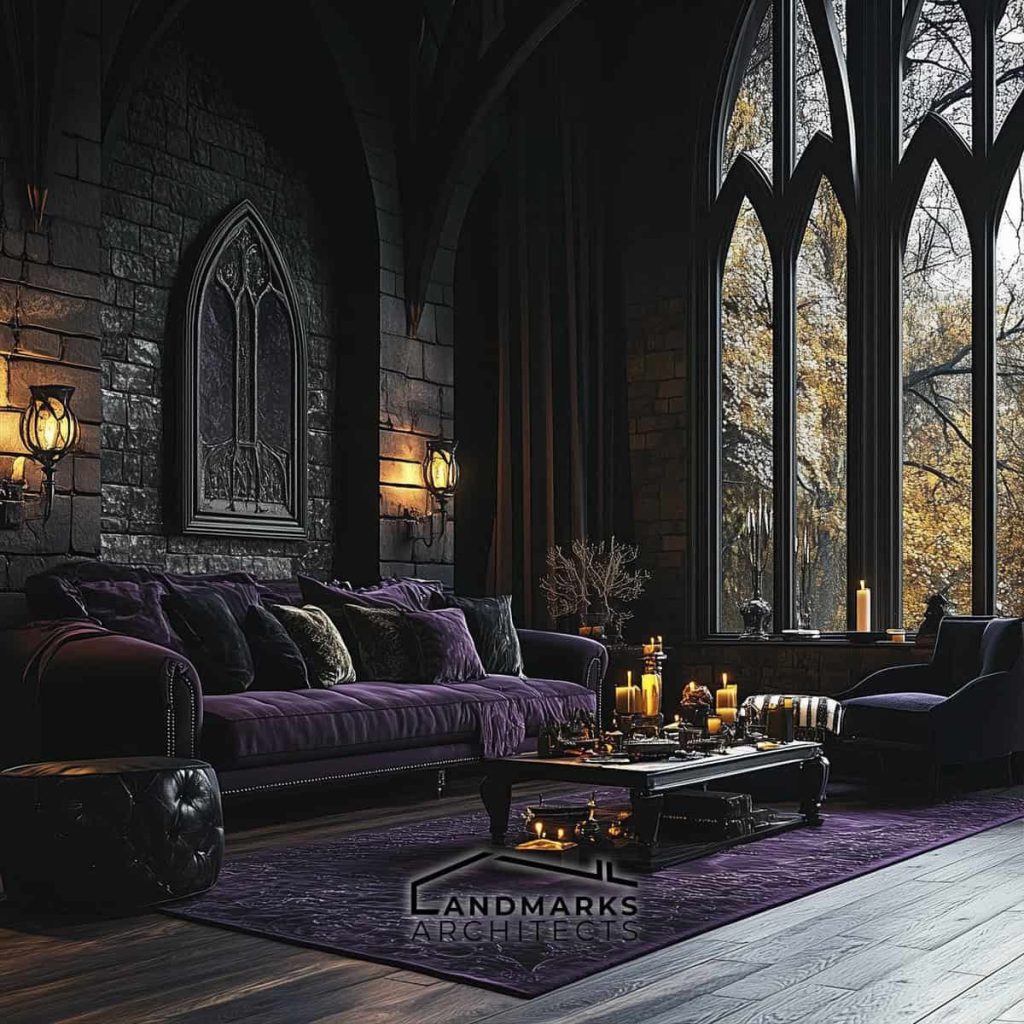
Incorporate architectural details reminiscent of gothic cathedrals and medieval castles to add authenticity to your decor. Consider installing arch-shaped mirrors, doorways, or window frames to evoke gothic architecture’s distinctive silhouettes.
For a more permanent transformation, look into adding decorative ceiling medallions, crown molding with gothic motifs, or wall panels with pointed arch details. If structural changes aren’t possible, decorative elements like wall-mounted tracery panels or fretwork screens can achieve a similar effect. These architectural touches serve as sophisticated nods to gothic design heritage while elevating the overall look of your space.
9. Statement Light Fixtures
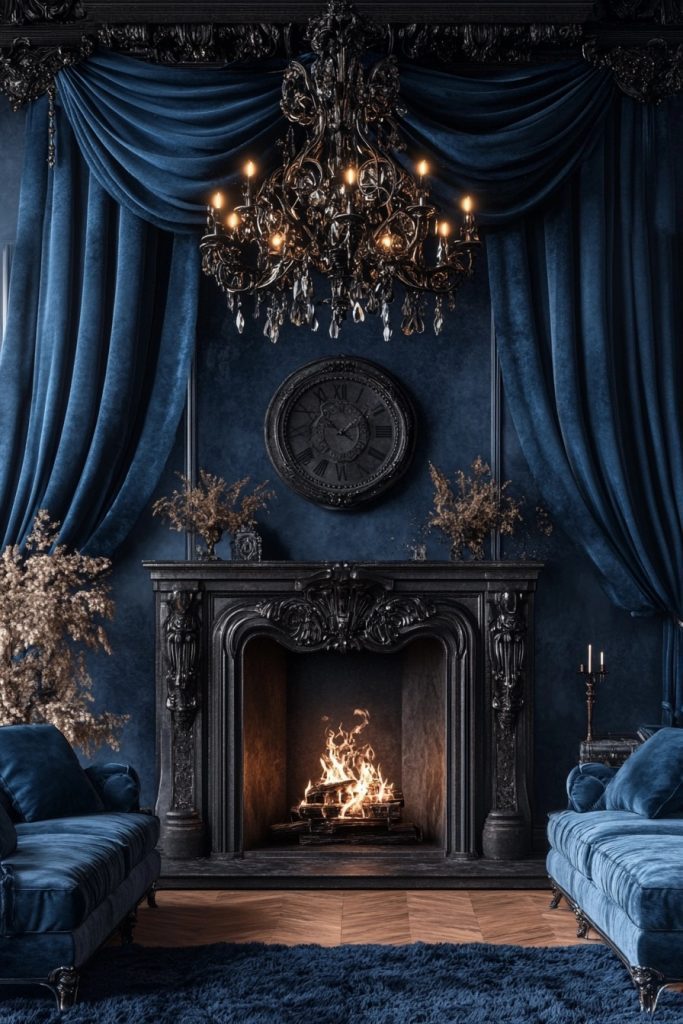
Replace standard lighting with dramatic fixtures that become focal points in their own right. Gothic-inspired chandeliers with scrollwork, medieval-style lanterns, or iron pendant lights completely transform the atmosphere of a room while providing necessary illumination.
Install dimmer switches to control the intensity of your lighting, allowing you to create the perfectly moody ambiance. For a balanced approach, combine statement lighting with subtle accent lights that highlight architectural features or art pieces. Remember that in gothic decor, lighting is not merely functional—it’s an essential design element that shapes the entire mood of your space.
10. Nature-Inspired Accents
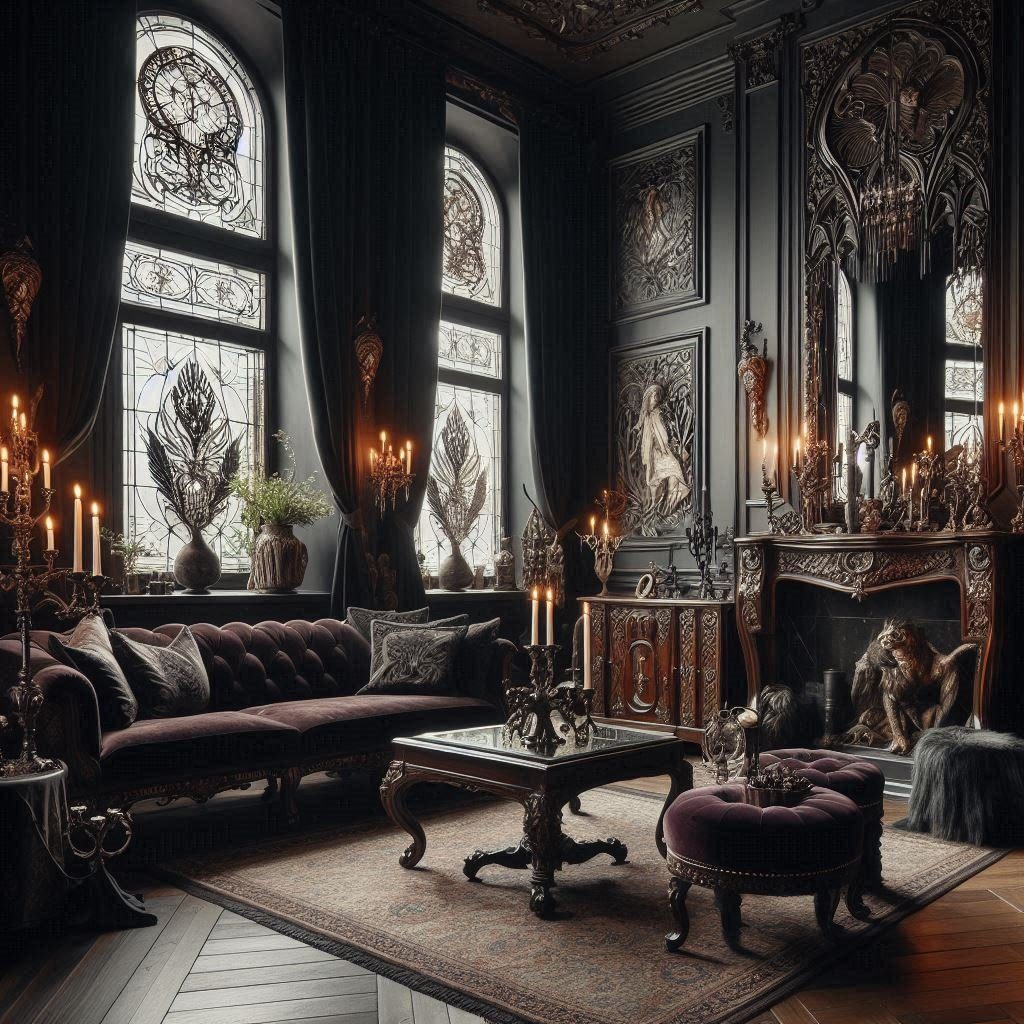
Gothic design has always maintained a connection to nature, albeit often with a darker, more mysterious interpretation. Incorporate botanical elements like dried flowers, preserved plants, or artistic representations of flora and fauna that lean toward the dramatic or unusual.
Look for decorative items featuring ravens, owls, or butterflies—creatures that symbolize transformation and mystery in gothic iconography. Preserved plants like roses, thistles, or eucalyptus arranged in dark vessels make striking centerpieces. For a modern twist, consider terrariums with unusual plants like air plants or small ferns, displayed under glass cloches or in geometric containers for a contemporary gothic look.
11. Gallery Walls with Gothic Art
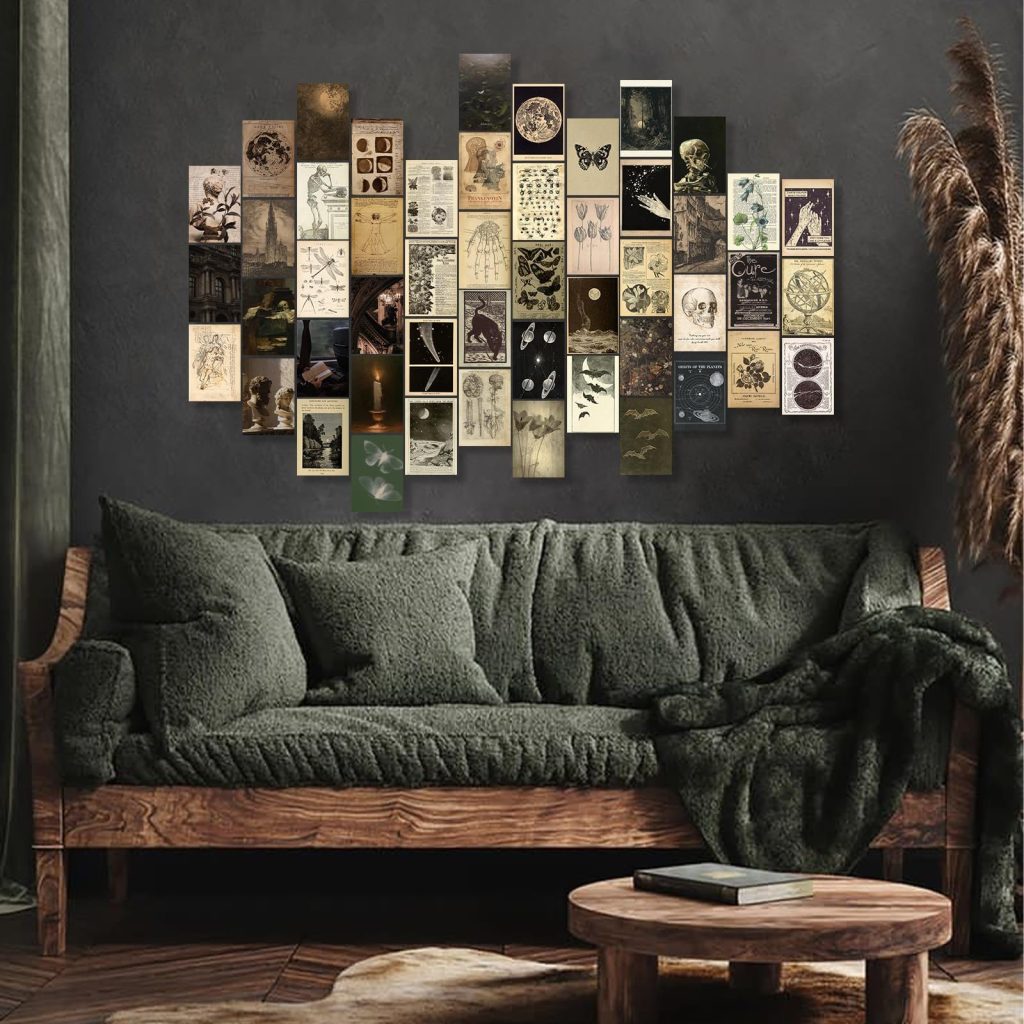
Create an impressive gallery wall featuring gothic-inspired artwork. Include reproductions of classic gothic paintings, contemporary dark art, anatomical illustrations, or Victorian-style silhouettes for an eclectic but cohesive display.
Frame your collection in ornate, antique-style frames—mixing gold, silver, and black finishes adds visual interest while maintaining the gothic theme. When arranging your gallery, create balance through thoughtful placement rather than perfect symmetry. Consider extending the display up toward the ceiling for a dramatic effect that draws the eye upward, emphasizing the vertical lines so characteristic of gothic architecture.
12. Statement Drapery
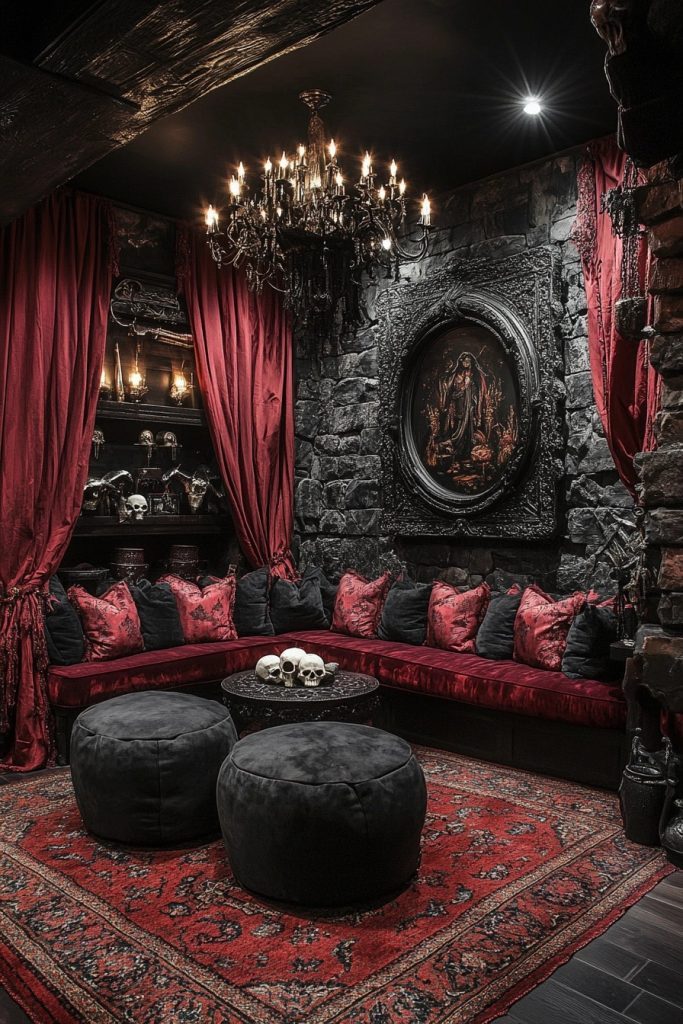
Windows dressed in sumptuous, floor-length drapery instantly elevate a room to gothic grandeur. Choose heavy fabrics like velvet or brocade in deep colors, and opt for fullness that creates dramatic folds when the curtains are closed.
Add decorative tie-backs with tassels or ornate holdbacks to frame your windows elegantly when the curtains are open. For additional drama, layer sheer panels behind heavier drapes to create depth and allow for light filtration options. Consider adding valances or pelmet boxes with gothic-inspired cutouts or detailing for a complete window treatment that frames your view while reinforcing the gothic aesthetic.
13. Skull and Skeleton Motifs
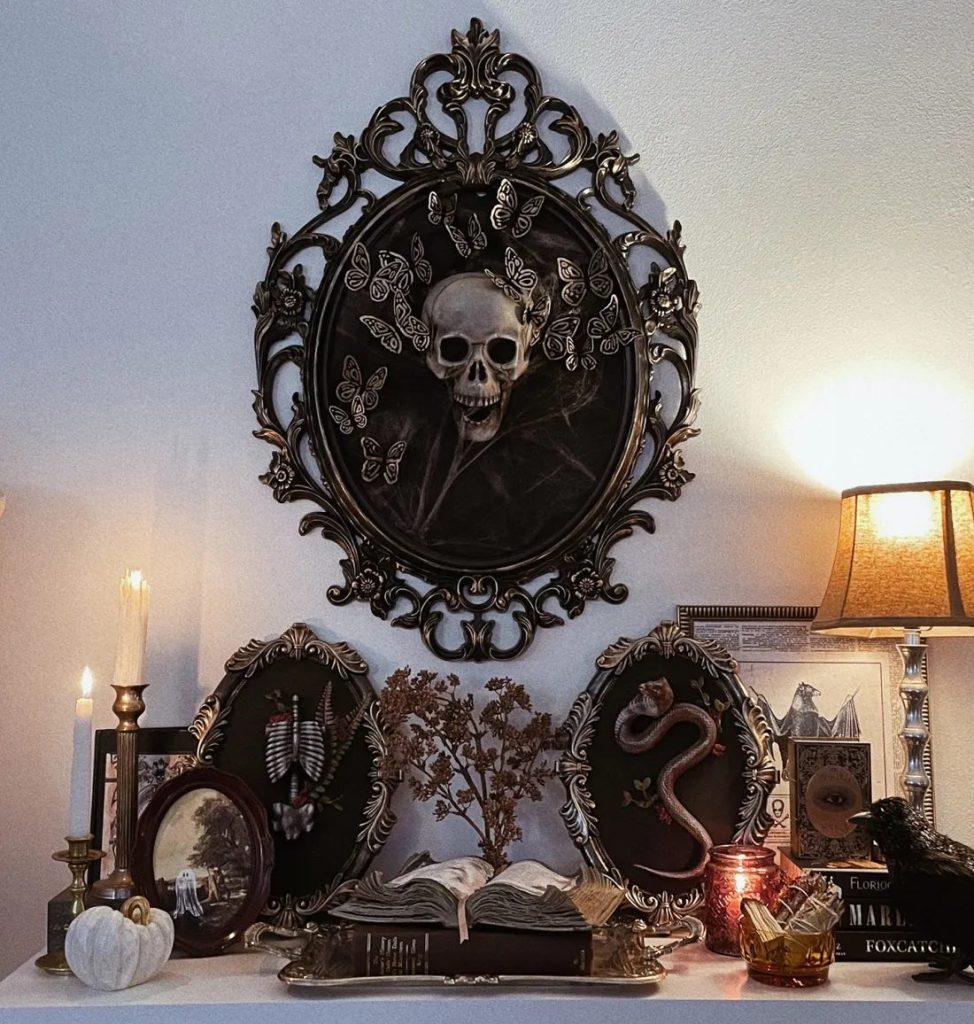
Tastefully incorporated memento mori elements add authentic gothic flair without veering into Halloween-decoration territory. Look for skull-shaped bookends, skeleton-key decor, or anatomically correct skull replicas crafted from materials like resin, ceramic, or metal.
These motifs can be introduced subtly through smaller accessories or more boldly as focal pieces. Position them thoughtfully within your decor scheme—a skull paperweight on a desk, anatomical drawings in your gallery wall, or delicate skeleton key ornaments hanging from drawer pulls. When incorporated with sophistication rather than shock value, these traditionally macabre elements become elegant reminders of gothic decor’s philosophical underpinnings.
14. Wrought Iron Accents
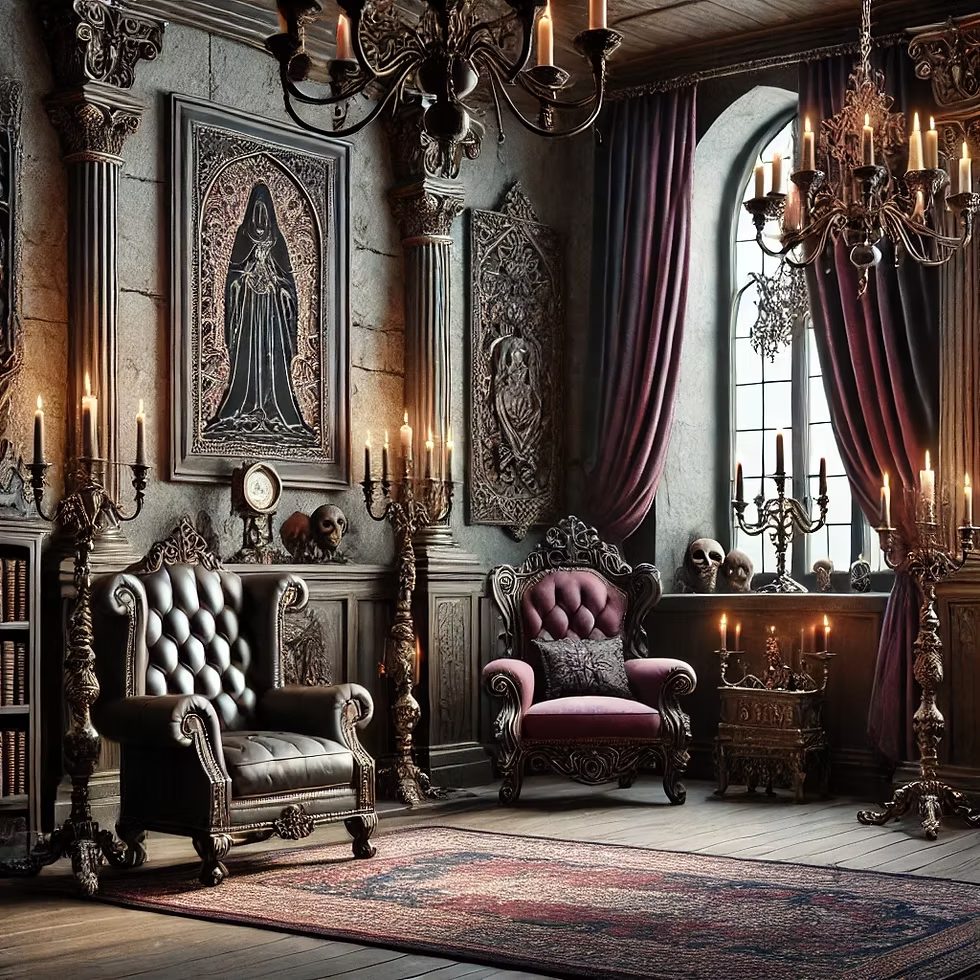
The strength and intricate detailing of wrought iron perfectly complement gothic design sensibilities. Incorporate this versatile material through furniture pieces like plant stands, side tables, or headboards featuring scrollwork and ornate patterns.
Beyond furniture, consider wrought iron wall decor, candle sconces, or decorative screens that add gothic character while creating interesting shadow patterns when lit. The dark finish of traditional wrought iron works beautifully against both light and dark wall colors, providing contrast or continuity depending on your color scheme. For outdoor spaces, wrought iron garden furniture, trellises, or lanterns extend your gothic aesthetic beyond interior walls.
15. Oversized Statement Artwork
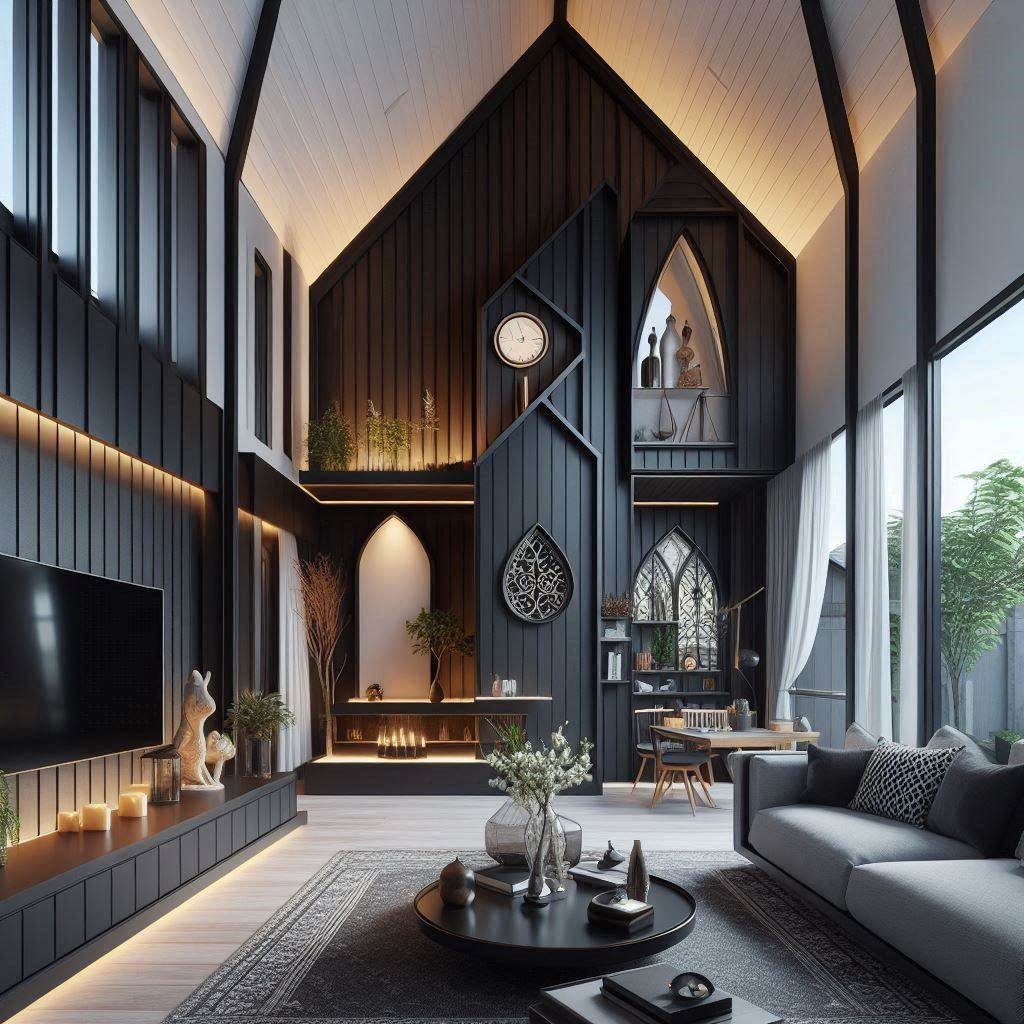
A single large-scale artwork can establish gothic atmosphere more efficiently than numerous smaller pieces. Look for paintings or prints featuring romantic landscapes with ruins, dramatic portraits, or abstract works in gothic color palettes dominated by deep reds, purples, blues, and blacks.
Position your statement piece where it will command attention—above a fireplace, centered on a large wall, or at the end of a hallway to draw visitors through your space. Choose frames that complement the gothic theme, either ornately carved in dark wood or metal with antiqued finishes. The right artwork serves not just as decoration but as a window into the emotional landscape of your gothic-inspired home.
16. Four-Poster or Canopy Beds
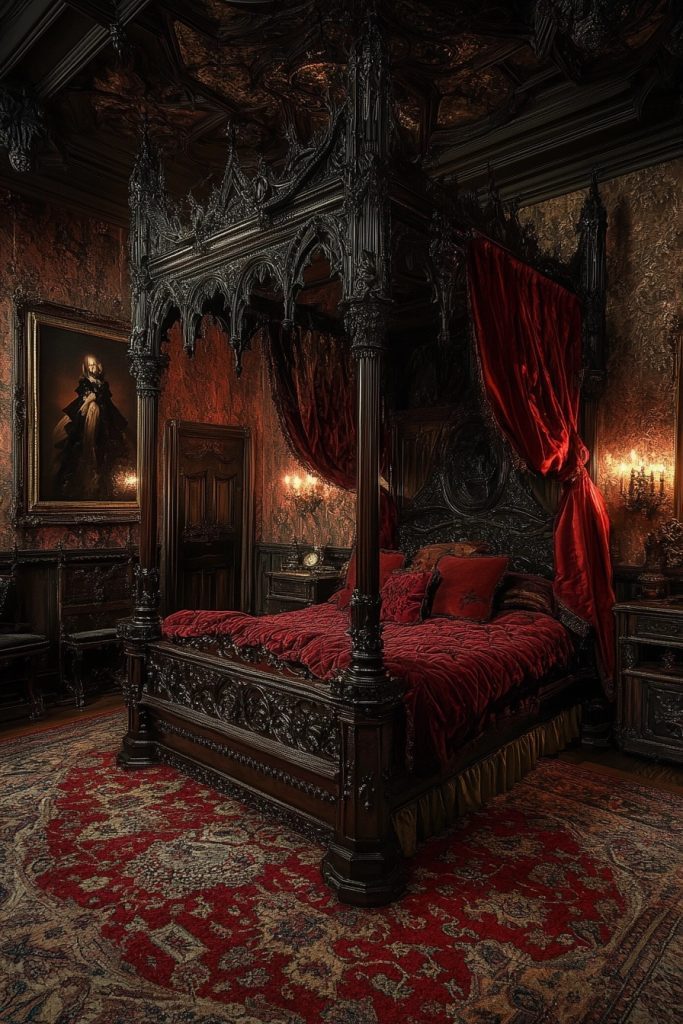
Transform your bedroom into a gothic sanctuary with a dramatic bed frame. Four-poster or canopy beds with ornate detailing and dark wood finishes become architectural elements in their own right, anchoring your bedroom design with unmistakable gothic grandeur.
Dress your statement bed with luxurious linens in jewel tones or deep neutrals, and consider adding bed curtains for an authentic medieval-inspired sleeping space. The vertical emphasis of these bed styles echoes gothic architecture’s soaring qualities while creating an intimate cocoon for rest. Even in smaller bedrooms, a scaled-down version of a four-poster bed can establish gothic character without overwhelming the space.
17. Gargoyle and Grotesque Figures
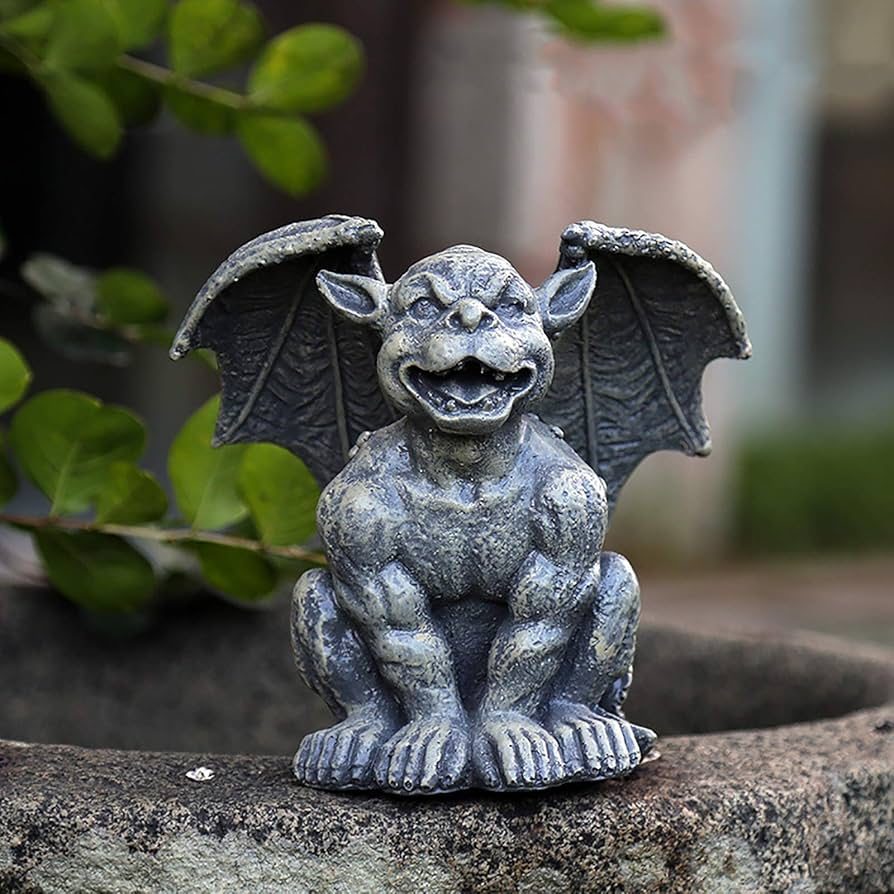
These traditional gothic architectural guardians make distinctive decorative elements for interior spaces. Place small gargoyle statues on mantels, bookshelves, or as doorstops for authentic gothic character with historical significance.
For exterior spaces, consider larger gargoyle figures as garden statuary or by entryways to create a dramatic first impression. These mythical creatures add a layer of symbolism and protection to your gothic decor scheme. Choose pieces made from quality materials like stone, resin, or metal that will develop patina over time, enhancing their ancient, watchful presence in your carefully curated gothic home.
Related Guide: 40 Spooky DIY Halloween Decor Ideas
18. Vintage Religious Artifacts
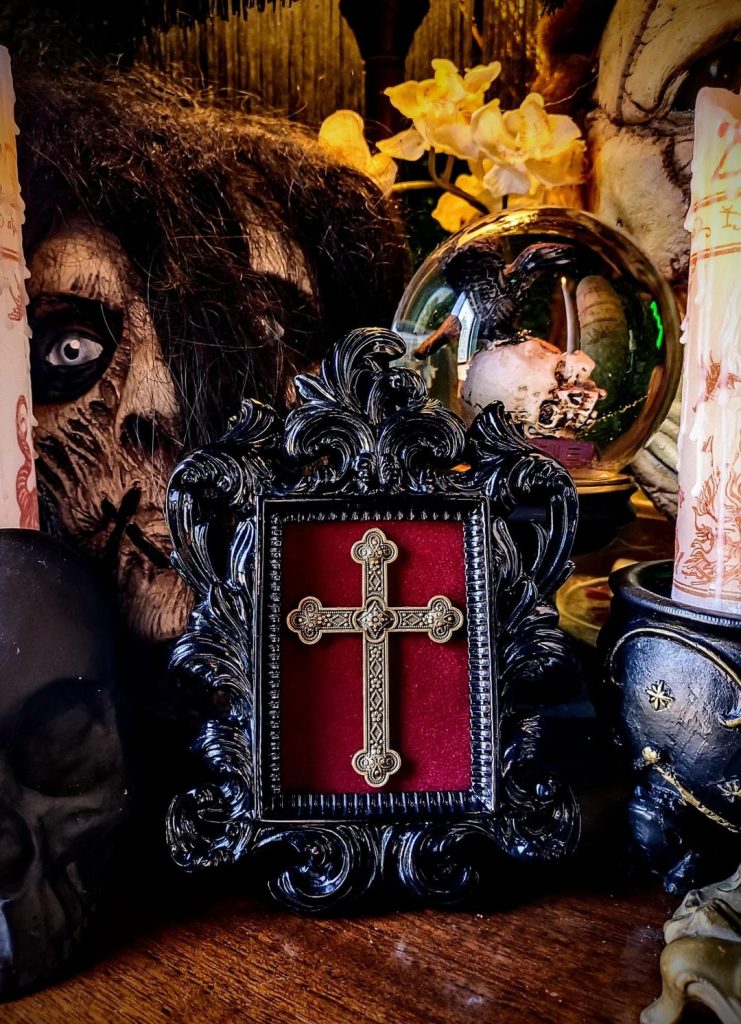
Incorporate thoughtfully selected religious items like antique crosses, prayer books, or ecclesiastical furniture pieces to reference gothic design’s cathedral origins. These elements add historical depth and spiritual dimension to your decor when arranged respectfully.
Source genuine antique pieces from reputable dealers, or look for quality reproductions that capture the patina and craftsmanship of authentic artifacts. Display these pieces prominently but tastefully—a collection of crosses on a dark wall, or a repurposed church pew in an entryway. These elements connect your space to gothic design’s rich religious heritage while adding unique character that can’t be replicated with mass-produced decor.
19. Dark Botanical Wallpaper
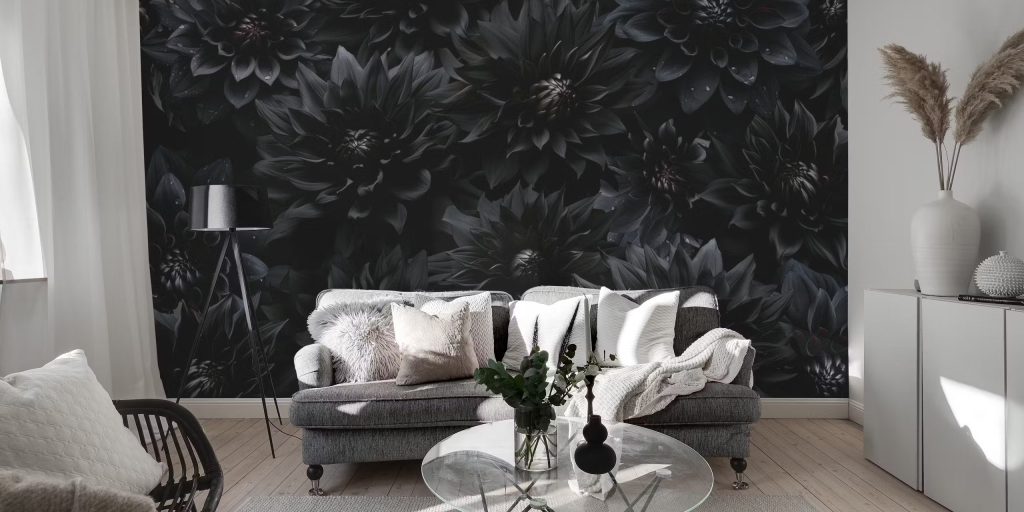
Make a bold statement with wallpaper featuring dark botanical patterns—think moody florals, thorny vines, or forest scenes rendered in deep, saturated colors. This contemporary take on gothic elements creates dramatic impact while maintaining sophistication.
Consider using botanical wallpaper on a single accent wall behind a bed or sofa, or in smaller spaces like powder rooms where the immersive effect can be particularly striking. Look for designs with metallic details that catch the light, adding dimension and luxury. This approach offers a perfect balance between traditional gothic motifs and modern design sensibilities, creating spaces that feel both timeless and current.
20. Taxidermy and Preserved Specimens
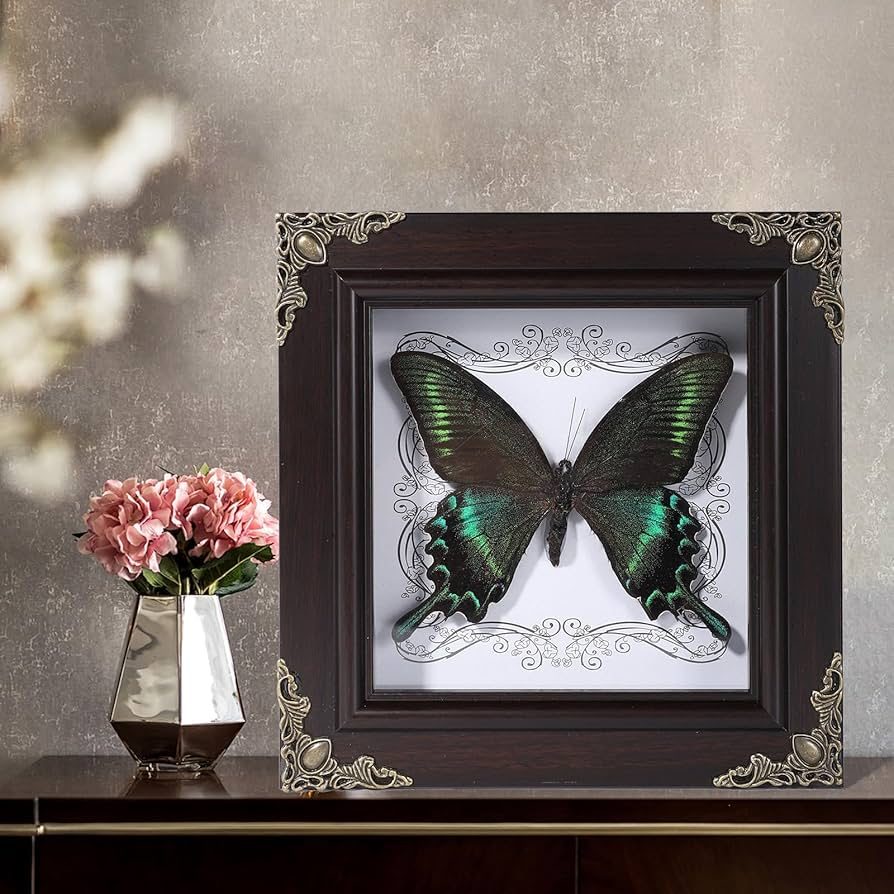
Ethically sourced taxidermy or preserved specimens add authentic Victorian-era gothic elements to your decor. Consider framed butterfly collections, bell jars containing preserved plants, or tasteful taxidermy pieces that reflect gothic design’s fascination with natural history.
Display these elements thoughtfully—a single striking piece can serve as a conversation starter without overwhelming your space. If traditional taxidermy feels too intense, look for artistic interpretations like ceramic animal skulls or paper butterflies under glass that reference the aesthetic without using actual specimens. These natural curiosities connect your decor to the Victorian cabinet of curiosities tradition that strongly influences gothic interior design.
21. Medieval-Inspired Tapestries
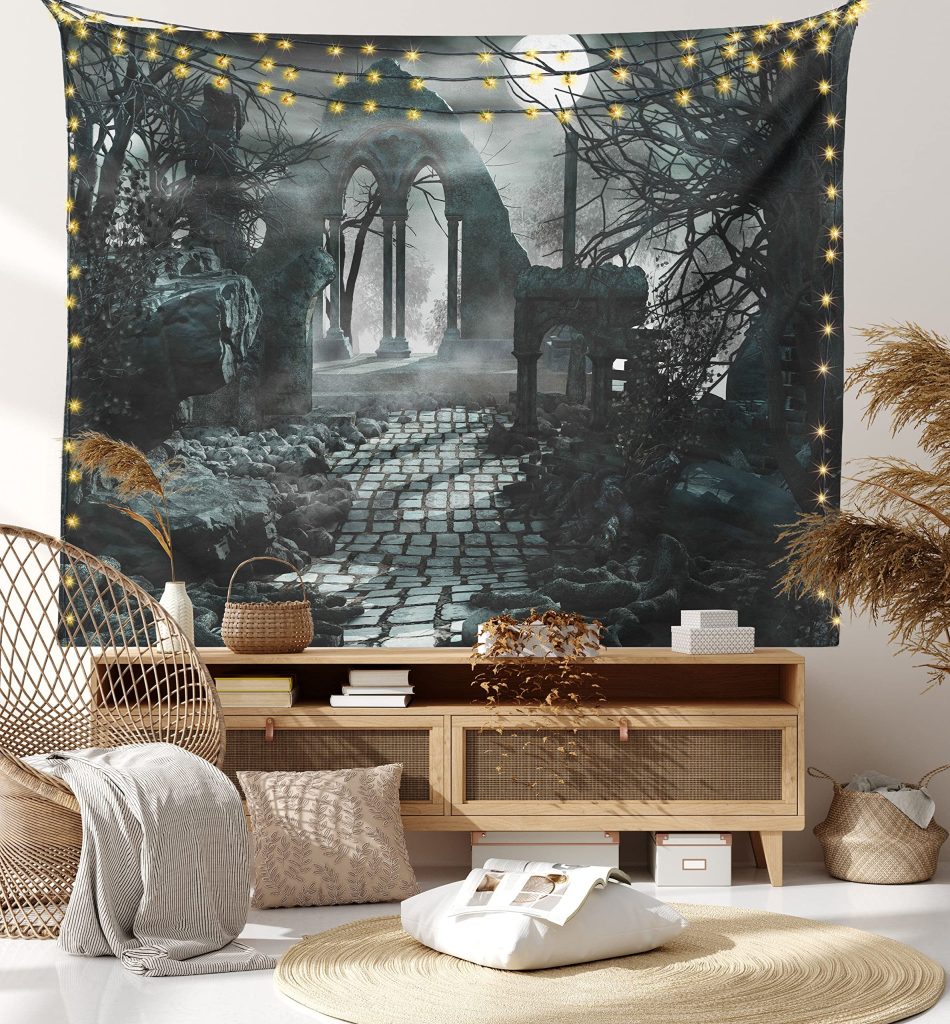
Hang richly detailed tapestries featuring medieval scenes, mythological imagery, or intricate patterns to add warmth, texture, and historical reference to your gothic interior. These substantial textile pieces improve acoustics while making a dramatic design statement.
Position tapestries on large wall spaces where their scale can be fully appreciated, or use smaller versions to soften the transition between architectural elements. Beyond walls, consider using tapestry fabric for upholstery projects or as luxurious table coverings for special occasions. The complex patterns and rich colors of well-chosen tapestries complement other gothic elements while adding a layer of storytelling to your decor.
22. Dramatic Ceiling Treatments
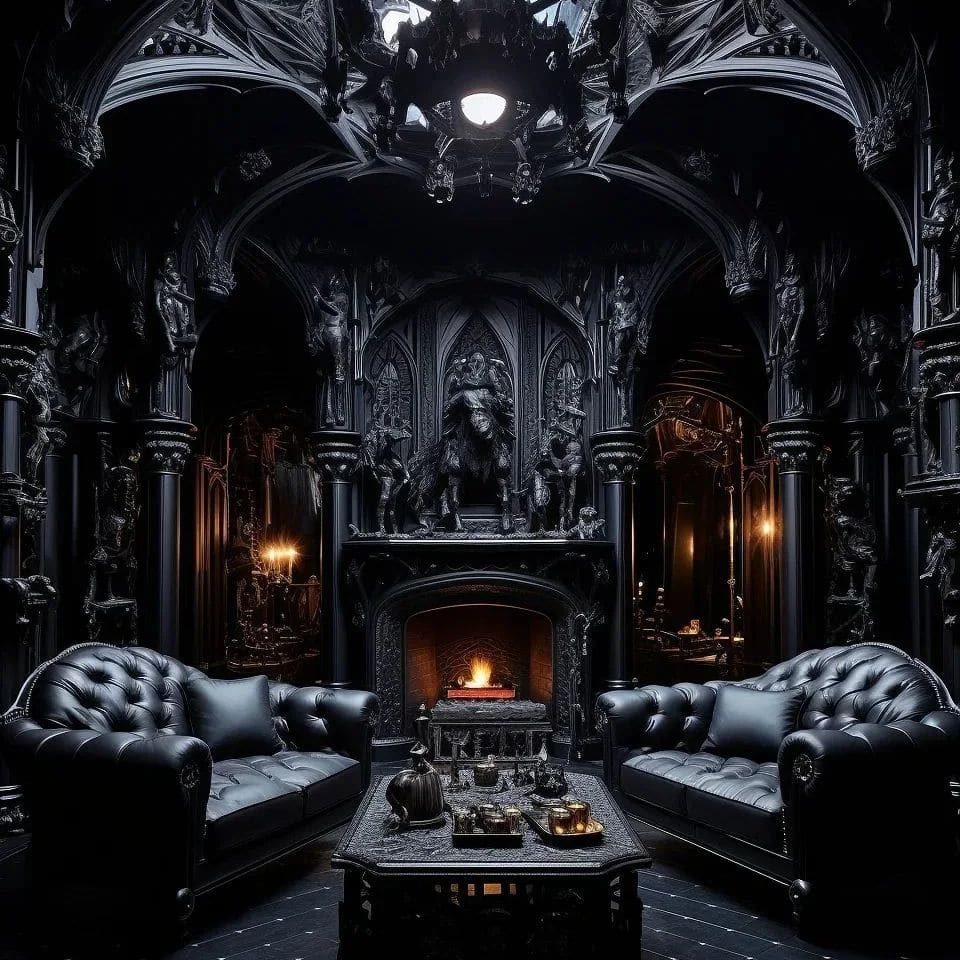
Draw the eye upward with ceiling treatments that add architectural interest and gothic character. Consider painting your ceiling in a deep color, installing decorative ceiling medallions, or adding faux wooden beams for old-world atmosphere.
For truly dramatic impact, investigate removable wallpaper designed for ceiling application, featuring patterns like stars, clouds, or gothic motifs. Even simple changes like replacing a standard light fixture with a gothic-inspired chandelier transforms the often-neglected “fifth wall” of your room. These vertical design elements create spatial drama reminiscent of gothic cathedrals’ soaring ceilings, albeit on a residential scale.
23. Crystal and Gemstone Accents
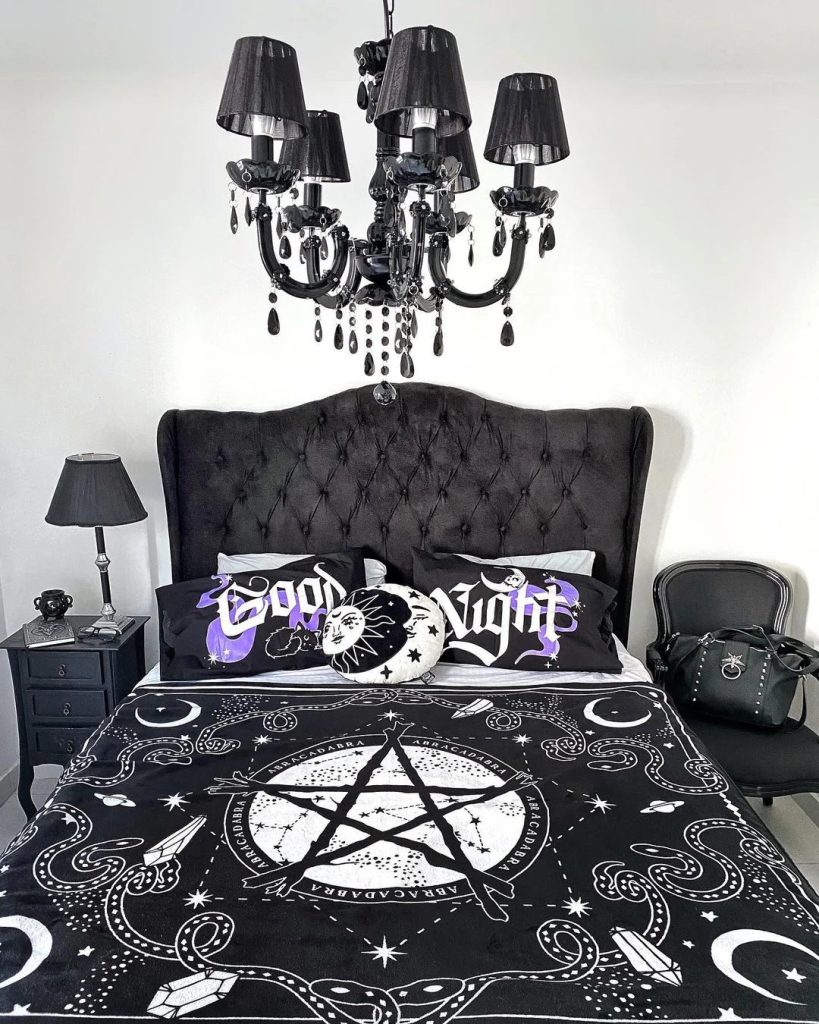
Incorporate the mystical elegance of crystals and gemstones to add sparkle and spiritual symbolism to your gothic decor. Large amethyst geodes, smoky quartz points, or black tourmaline specimens make striking decorative elements that complement the gothic palette while adding earth-derived luxury.
Display these natural treasures on mantels, bookshelves, or coffee tables where they can catch and reflect light from your candles or gothic light fixtures. Beyond decorative specimens, consider incorporating crystals into functional items like bookends, drawer pulls, or even lamp bases. These elements add a contemporary, slightly mystical dimension to traditional gothic decor that feels fresh and personal.
24. Antique Silver and Metalwork
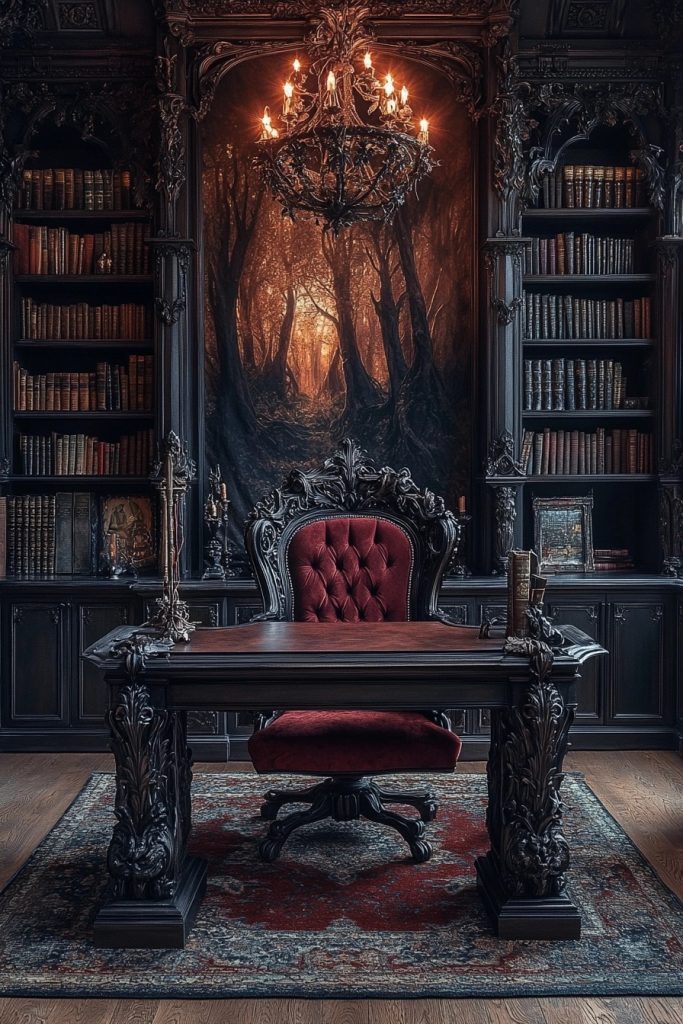
Collect and display antique or antique-style silver pieces to add gothic luxury and patina to your interior. Tarnished silver candlesticks, ornate picture frames, or decorative serving pieces develop a mysterious, aged quality that perfectly complements gothic design sensibilities.
Allow your silver pieces to develop natural patina rather than keeping them brilliantly polished—the darkened, slightly oxidized finish enhances the gothic mood. Arrange collections on dark wood surfaces for maximum impact, or place individual statement pieces throughout your space as unexpected touches of subdued elegance. These metallic elements add subtle gleam and historical depth to your carefully curated gothic sanctuary.
25. Gothic-Inspired Garden Elements
Extend your gothic aesthetic outdoors with garden elements that complement your interior design. Consider wrought iron garden furniture, stone planters, or gothic-inspired trellises and arbors that create architectural interest while supporting climbing roses or ivy.
Choose plants with gothic associations—deep purple or black flowers, silvery foliage, or plants with thorns and dramatic silhouettes. Incorporate statuary like classical figures, stone angels, or small fountains to create contemplative focal points. These outdoor extensions of your gothic design philosophy create transitional spaces that maintain the atmosphere of your interior while connecting harmoniously with the natural world.
Conclusion
Gothic home decor offers a uniquely expressive pathway to creating spaces that are both dramatically beautiful and deeply personal. By thoughtfully incorporating elements from this rich design tradition—from statement furniture and moody color palettes to carefully curated accessories—you can transform any home into a sanctuary of gothic elegance.
The key to successful gothic decor lies in balancing darkness with light, ornate details with clean space, and historical references with contemporary sensibilities.
Whether you embrace this aesthetic throughout your entire home or simply incorporate select elements into your existing decor, gothic design offers endless possibilities for creating spaces that are as intellectually stimulating as they are visually striking.
Ultimately, the most successful gothic interiors reflect their inhabitants’ personalities while honoring the timeless appeal of this enduringly captivating aesthetic.

